Pros
Cons
Introduction
Front
{{section_header}}{{section.name}}{{/section_header}}

Back
{{section_header}}{{section.name}}{{/section_header}}

Sides
{{section_header}}{{section.name}}{{/section_header}}

Top
{{section_header}}{{section.name}}{{/section_header}}

Bottom
{{section_header}}{{section.name}}{{/section_header}}

In the Box
{{section_header}}{{section.name}}{{/section_header}}

In the box with the camera itself, you get:
- DE-A65 Charger
- DMW-BCG10PP battery
- USB cable
- A/V video cable
- Wrist strap
- Manual
- Software CD
Color
{{section_header}}{{section.name}}{{/section_header}}
In our tests for color accuracy, we found that the ZS3 performed extremely well, capturing most colors with spot-in accuracy. We found that the only colors that the camera struggled with were the purples and reds, which were slightly deeper than the originals in the color chart that we use for our testing. But even these colors were pretty close; as you can see from the samples below, the differences between the ideal (the original color) and the captured color were very minor. More on how we test color.
The ZS3 offers 4 color modes: Standard, Natural, Vivid and Black & White. We found that the Standard had the best color accuracy (the results below were taken in this mode), but only just; the Natural mode was also very accurate, but the colors were significantly less saturated. The Vivid mode turned the saturation dial up to 11: we found that it had saturation of 126 per cent, and colors looked very cartoonish.
Color Modes
{{section_header}}{{section.name}}{{/section_header}}
The ZS3 offers just a limited selection of color modes: Standard, Natural, Vivid and Black and White. But that's enough for everyday use; we generally recommend that people stick to the most accurate and process colors afterwards, anyway.
Noise
{{section_header}}{{section.name}}{{/section_header}}
The Panasonic ZS3 had some interesting results in our tests on the amount of noise in images; we found tat the noise was low until an ISO level of 400, but it quickly climbed above that to rather high levels. You can see the results in the graph below; the lines are level until ISO 400, where they start to climb rapidly. The two lines represent the two light levels that we test at: 3000 lux (about the same as outdoors on a cloudy day) and60 lux (about the same amount of light as you would get from indoor lighting). More on how we test noise.
As a general conclusion, the ZS3 performs well at ISO levels of up to 800. However, we would recommend that you avoid using the ISO 1600 setting unless it is absolutely necessary: as you can see from the samples below and those on our sample photos page, the images it captures at this ISO level are very noisy, and this will be easily visible in all images.
When we compared the performance of the ZS3 to other cameras, we found that it performs comparably at the lower ISO levels, but the ISO 1600 noise is significantly higher than the other cameras.
{{comparison_bars title="Noise Score Comparison", attribute="Noise Score", xLabel="Noise Score"}}
ISO
{{section_header}}{{section.name}}{{/section_header}}
The ZS3 has an ISO range in most modes of 80 to 1600, but you have a fair amount of control over how this range is used. The ZS3 offers several ISO modes that restrict this range: ISOMAX400 uses 80 to 400, ISOMAX 800 uses 80 to 800 and ISOMAX1600 uses the entire range. Given the large amount of noise that the ISO 1600 setting involves, we would generally recommend that you set this to ISOMAX800.
For shooting in lower light, a high sensitivity mode is available which expands this range to 1600 to 6400. However, this reduces the resolution of the camera to 3 megapixels, and images taken in this mode are rather noisy, so it should only be used when it is absolutely required. See the sample photos page for examples.
NOTE: The images above are not used in our testing or scoring, but are included here to show real-world examples of the differences between cameras at the various ISO settings.
Resolution
{{section_header}}{{section.name}}{{/section_header}}
Overall, we were impressed with the quality of the images that the ZS3 took in terms of the levels of distortion, sharpness and chromatic aberration. We found that the images had very little distortion and very low chromatic aberration, while still retaining good levels of sharpness. More on how we test resolution.
Distortion ({{product.raw_scores['Distortion Score']}})
We usually expect to see some distortion in the images taken by cameras with long zoom lenses, but the distortion across the zoom range of the ZS3 remained minimal. They were not distortion free, though; we saw a small amount of barrel distortion at the wide and middle points of the zoom range, and a small amount of pin cushioning at the telephoto end, but all of these were very low; the highest was 1.42 per cent at the middle of the range, which is barely noticeable.
Sharpness ({{product.raw_scores['Sharpness Score']}})
We also found that the images that the ZS3 captured had good sharpness, with fine details in the subjects being captured well. We did find that the edges of the frame got a little soft at the longest zoom setting, but this sharpness falloff was smaller than many other cameras.
Chromatic Aberration ({{product.raw_scores['Chromatic Aberration Score']}})
We found some chromatic aberration in the images that the ZS3 captured. Chromatic aberration is caused when the optics of the lens diffract colors of light differently, causing a colored fringe on sharp edges. This was most pronounced at the longer end of the zoom range and at the edges of the frame, but again it was much less sgnificant than many other cameras that we've tested.
Quality & Size Options
{{section_header}}{{section.name}}{{/section_header}}
The ZS3 offers plenty of choice when it comes to the size of the photos that it captures: you can set it to the full 10 megapixel resolution (3648 by 2736) or at any of 6 options that go down to 0.3 megapixels (640 by 480). At any of these settings, you can also set the aspect ratio of the image to any one of three options: 4:3, 3:2 and 16:9. In addition, there are two choices for the image quality: fine or standard.
Image Stabilization
{{section_header}}{{section.name}}{{/section_header}}
The ZS3 uses an optical image stabilization system, where an element in the lens shifts to compensate for hand shake. We found this to be very effective; the images that we captured with this enabled at our testing shutter speed of 1/30 of a second were significantly sharper with the camera in IS mode 2, the most aggressive of the stabilization settings. More on how we test image stabilization.
Video Mode
{{section_header}}{{section.name}}{{/section_header}}
The ZS3 captures video at a resolution of up to 1280 by 720 and saves them in either AVCHD or Motion JPEG format. We were impressed with the quality of the captured video and the usability of the camera as a camcorder: you can use the optical zoom while recording, and you also get a lot of control over the settings. The ZS3 also provides access to white balance for videos, has a number of different auto focus modes and includes a feature that tries to reduce wind noise from the microphones.
Video Color
{{section_header}}{{section.name}}{{/section_header}}
We were extremely impressed with the color accuracy of the videos that the ZS3 captured; they had accurate color that was a very good representation of the original colors in our test chart. We also found that the colors were not oversaturated. Many cameras amp up the saturation of the colors to make the video look more attractive, but the ZS3 videos had colors had very natural saturation. More on how we test video color.
{{comparison_bars title="Video Color Score Comparison", attribute="Video Color Score", xLabel="Video Color Score"}}
Video Sharpness
{{section_header}}{{section.name}}{{/section_header}}
We were also favorably impressed with the sharpness of the video that the ZS3 captured; fine details in our test charts were well reproduced, even when the camera was panning left and right. The ZS3 captures video at a resolution of up to 1280 by 720 pixels, which is the same as a 720p HDTV, and the extra resolution definitely shows here; the video looks much sharper and clearer than standard definition camcorders. It is also much sharper than the Kodak Z950, which also captures video at the same resolution. More on how we test video sharpness.
{{comparison_bars title="Video Color Sharpness Comparison", attribute="Video Sharpness Score", xLabel="Video Sharpness Score"}}
Playback Mode
{{section_header}}{{section.name}}{{/section_header}}
The ZS3 allows you to do a lot with the photos you have taken. You can look at groups of them at once (up to 36 at once on screen), look at those in a specific category (such as those with faces, landscapes, etc) or pick those taken on a certain date. You can also take a very close look at them with a 16x zoom on playback that lets you get right in to see the details. There are a couple of things missing, though; there is no calendar view, and there is no way to sort images into albums.
In-Camera Editing
{{section_header}}{{section.name}}{{/section_header}}
Only a handful of basic image editing features are on offer with this camera: you can crop, resize and rotate images, but you cannot do any color correction, contrast adjustments or other tweaking. This many not be a huge loss, though; most of these features are better handled in a dedicated image editing program on a computer, anyway.
Direct Print Options
{{section_header}}{{section.name}}{{/section_header}}
Support is included for the common DPOF and PictBridge printing features. DPOF allows you to mark photos for printing on the memory card, and a compatible printer will notice this and select the marked photos for printing. PictBridge allows you to connect directly to a compatible printer through the USB cable, and select and print images from the camera.
Viewfinder
{{section_header}}{{section.name}}{{/section_header}}
There is no viewfinder on the ZS3: everything is handled through the LCD screen.
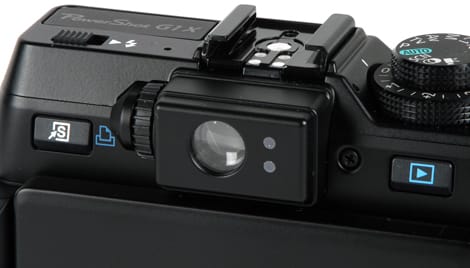

... and it has a diopter adjustment ring.
Display
{{section_header}}{{section.name}}{{/section_header}}
The 3-inch LCD screen on the back of the ZS3 is its main interface to the rest of the world, and it does a good job of this. With 460k pixels, the images on the screen are clear, and the colors of the screen were clear and bright. It was a little difficult to see in bright sunlight, though, and we would have liked to seen even a small viewfinder to use in these situations.

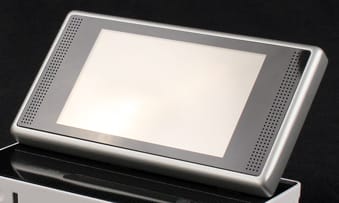
...but it turns into a nice 3-inch widescreen in playback mode.
Flash
{{section_header}}{{section.name}}{{/section_header}}
The small flash of the ZS3 is built into the camera body just to the left of the lens itself. It is on the small side, but it has a decent amount of power. We found that it was capable of illuminating a face up to 10 to 12 feet away. Panasonic claim a range of up to 17 feet, but that's somewhat over optimistic. Four flash modes are available: auto, auto red eye, forced on and forced off. The red eye mode uses a single pre-flash to contract the iris and minimize red-eye. This should be used, as the close proximity of the flash to the lens tends to exaggerate red-eye. In the Normal mode, you also get options for a slow synch/red eye mode, which combines a slow shutter speed and a flash to take night portraits.
There is no way to attach an external flash; there is no flash shoe or external flash trigger.

The flash emitter pops up from the top of the body via a mechanical release.
Lens
{{section_header}}{{section.name}}{{/section_header}}
The lens of the ZS3 is a DC Vario-Elmar with a focal length of 4.1 to 49.2mm, which works out as being equivalent to a 25 to 400mm focal length on a 35mm film camera. That is a good range: 25mm at the wide end gives you plenty of room to get large groups or expansive landscapes into the frame, while 400mm is long enough to get close to the action.

When the camera is turned off, the lens fits into the camera body and a cover goes over the front element of the lens. This is rather flimsy, and could be easily pushed out of the way, so this camera should not be stored with keys or other objects that could push past this and scratch the front element.
Below are examples of the range of this 12x zoom range, from the widest to the zoomiest.
Battery
{{section_header}}{{section.name}}{{/section_header}}
The battery of the ZS3 is a proprietary Lithium Ion battery (the model number is DMW-BCG10PP) that holds around 895 mAh of charge. This has to be removed from the camera and recharged in the included charger: it cannot be charged in the camera itself.

Memory
{{section_header}}{{section.name}}{{/section_header}}
The ZS3 can stash photos in two places: in the approx. 45MB of memory built into the camera or on a SD or SDHC memory card. An 8GB SDHc card will cost about $20, but it is good to have a little extra space on the internal memory. At the highest quality and resolution, this 45MB can hold 6 or 7 images.

Jacks, Ports & Plugs
{{section_header}}{{section.name}}{{/section_header}}
There are just two ports on the ZS3, with both located under a small panel on the right side of the body. At the top is a mini HDMI port for viewing images and photos on a HDTV. Below this is the AV/Digital/Multi port, where a number of leads can be used to connect the camera to a computer via the included USB cable or a standard definition TV via the A/V out cable.
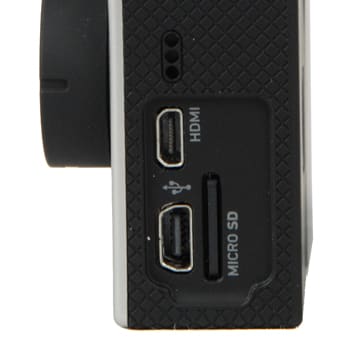
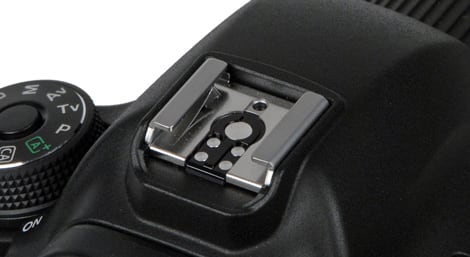
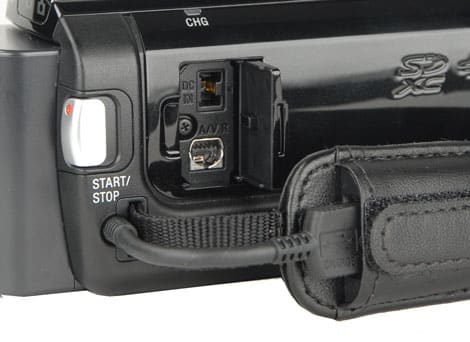
The DC-input and multi-AV port are located on the right side of the camcorder.
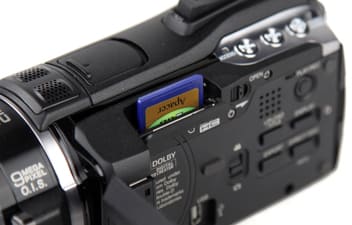
... as is the SD/SDHC card slot.
Shooting Modes
{{section_header}}{{section.name}}{{/section_header}}
The ZS3 has two automatic modes: the normal mode and the intelligent Auto mode. The normal mode is analogous to a program mode on most other cameras: the camera makes most of the decisions, but the user can jump in and tweak some settings, such as
The Intelligent Auto mode, as the name suggests, puts the control into the cameras hands. When the shutter is pressed down half way, the camera will choose the appropriate scene mode from 7 options (including iPortrait, iMacro and iBaby) and sets the camera appropriately.
Auto Mode Features
Focus - The ZS3 provides a lot of different focusing modes. The fastest is the 1-area high speed mode, which uses an area in the center of the screen as the focus point. This was pretty fast; it seldom took more than half a second or so to snap into focus. If you want to use different approaches to focusing, there is the spot mode (which uses a tiny area right in the middle of the image) or the 11 area, which uses 11 focus spots, and concentrates on the closest one. There is also a face detection option and an AF tracking option, which tries to track a moving object in the frame. The latter could be useful for subjects such as pets or a football game, as you can focus on the subject, but then take a photo with it not in the center of the frame.
Exposure - The ZS3 is unusual in including both exposure compensation and auto exposure bracketing; most point and shoot cameras just offer exposure compensation. When auto exposure bracketing is enabled, the ZS3 can take 3 images with between 1 and 1/3 of a stop of compensation applied. So, with this enabled, you would get an image with -1 stop, one with no compensation and one with +1 stop of compensation. You can also use this feature to take 3 images with different aspect ratios, which could be useful if you aren't sure which aspect ratio would be the best, and you want to try them all without cropping the image.
Metering - Evaluative, center weighted and spot metering modes are available on the ZS3. These are buried rather deeply in the menu system, though; changing from one to the another involves a lot of button pushing and scrolling around the menu system.
Aperture - The ZS3 has a very limited aperture range: at the wide end of the zoom range, the aperture range is f/3.3 to f/6.3. At the telephoto end, this range shrinks to f/4.9 to f/6.3. That small range does limit the camera: the relatively small numbers of the maximum aperture means that it does not have a particularly wide depth of field.
Shutter Speeds - The shutter speed range of the ZS3 in most modes is from 1/2000 of a second down to 8 seconds. This can be extended right out to 60 seconds in the Starry Sky scene mode, which is for taking starscapes.
Self-Timer - Two self-timer modes are available that give a 10 second or 2 second delay. There are none of the smile shutter or interval shooting features found on other cameras.

The full mode dial is nice, but frequently rotates by accident.
Scene Modes
In addition, the ZS3 has a huge selection of scene modes on offer: 26 in all. These can be chosen by setting the mode to the scene spot, or two frequently used modes can be assigned to the MS1 and MS2 spots on the scene dial. This is a good approach, as it means that the frequently used modes can be quickly set, while there are a good selection of other modes also on offer.
Picture Effects
{{section_header}}{{section.name}}{{/section_header}}
The ZS3 offers a number of photo effects, which it refers to as color modes: Standard, Natural Vivid, Black & White, Sepia, Cool and Warm. Examples of all of these are below.
Manual Controls
{{section_header}}{{section.name}}{{/section_header}}
The usual selection of white balance features are on offer: you can set the camera to a number of presets (Daylight, Cloudy, Shade and Halogen), set it to an automatic mode, or set it to an evaluative mode where you measure the white balance. To do this, you have to go into the main menu, select the Set option and point the camera at a white object.
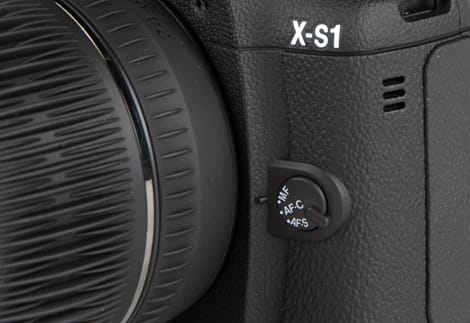
A dedicated focus-mode switch on the front panel.
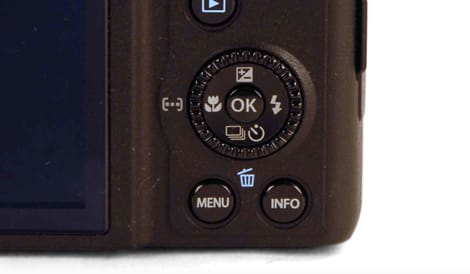
The scroll wheel surrounding the d-pad is neither awful nor perfect.
Drive/Burst Mode
{{section_header}}{{section.name}}{{/section_header}}
Two modes that take a burst of shots are available: a short burst mode that captures 3 images at the fine quality setting (or 5 at the standard quality setting), and a continuous mode that keeps capturing for as long as the shutter is held down.
Shot to Shot ({{product.raw_scores['Shot to Shot Score']}})
In the short burst mode, we found that the ZS3 was capable of capturing about 1.6 frames a second. In the continuous mode, the camera managed about 1.3 frames a second. Both of these figures are significantly less than Panasonic's claimed 2.5 frames a second.
Handling
{{section_header}}{{section.name}}{{/section_header}}
The ZS3 fits mostly well into the hand, but it does feel a little loose: the raised ridge on the side for the fingers to grip onto is small, and the sleek metal skin of the body looks good, but is rather slick, especially with sweaty hands. Both of these are presumably why Panasonic went with a wrist strap as a backup, as the camera is rather easy to drop.


We also found that the ring finger had a tendency to end up partly covering the flash, which caused a shadow in some photos.


These dedicated buttons give you quick access to aperture and shutter speed controls.
Buttons & Dials
{{section_header}}{{section.name}}{{/section_header}}
The shutter and zoom controls of the ZS3 are well located, falling comfortably under the tip of the index finger of the right hand. It is also easy to move from one to the other, so you can zoom in or out and then take a photo quickly. The other controls are a bit more awkward; the position of the mode dial can be changed with one hand, but it is awkward to do. The other controls require both hands as they are all on the back of the camera, including the button that starts videos recording.
Once you have the camera held in two hands, the controls are relatively easy to use.


Menus
{{section_header}}{{section.name}}{{/section_header}}
The menus of the ZS3 are divided into two parts: the quick menu and the main menu. The quick menu (accessed by pressing the Q Menu button) contains the basic shooting controls that are used more frequently, such as ISO settings and image size. These are arranged along the top of the screen, and you use the directional control to move and select the desired option.
The main menu is accessed by hitting the menu button in the middle of the directional control and is where the more in-depth controls are located. These are divided into three tabs: Rec, Motion Picture and Setup. The Rec controls include features such as picture quality and the intelligent ISO settings in addition to all of the options on the quick menu.
Manual & Learning
{{section_header}}{{section.name}}{{/section_header}}
The ZS3 comes with an extensive printed manual which covers every aspect of the camera's performance in some detail. This is mostly well written with the first few pages forming a quick start guide. The same manual covers both the ZS3 and the ZS1, and it isn't always clear which section is referring to which camera, as they have a different set of features. the manual that came with our review model also contains a number of spelling, typographical and other errors, and the index is inaccurate, sometimes by 3 or 4 pages. However, most of these seem to have been corrected in the revised version which can be downloaded here.
Nikon Coolpix L100 Comparison
In our tests, we found that the Panasonic ZS3 was the superior camera in most respects: It scored higher in our tests for color, sharpness and image stabilization. The only test where the Z950 was superior was in noise, and that was because Kodak seems to be more aggressive with the noise processing than Panasonic. The ZS3 is also the smaller and lighter camera that would fit into a shirt pocket, while the Z950 is significantly chunkier. The ZS3 is more expensive, though, but we'd recommend spending the extra if you have the bank balance to cover it.
Canon PowerShot SX120 IS Comparison
The Panasonic Lumix DSC-ZS3 is the more expensive camera, but you get a lot more for your money: better performance, a better screen, a smaller package and much more control over the picture taking process.
In our tests, we found that the Panasonic had significantly better performance on most of our tests: it had better color, sharper images and a more effective stabilization system. It also has a very decent selection of controls which provide the photographer with a decent selection of options (although there is no full manual mode), while the Nikon gives you little or not control over how these features are set up and controlled.
The only thing that you get more of with the Nikon L100 is a longer zoom, and that's not by that much. The Panasonic has a 12x zoom with an equivalent focal length of 25mm to 300mm, while the Nikon L100 goes from 28mm to 420mm. So, the Panasonic is actually slightly wider, but the Nikon has the longer zoom.
COMP 3
The Panasonic Lumix DMC-ZS3 is slightly more expensive than the Canon PowerShot SX120, but it also has a wider set of features and better performance. The ZS3 has a 12x zoom lens, while the SX120 has just 10x zoom to give. The ZS3 also captures video in high definition, and we found that the video it captured was significantly sharper than the Canon. But it was a pretty even race when it comes to the quality of the still images: both did an excellent job of producing sharp, bright images with good color. The Canon did have slightly less noise than the Panasonic, though, which could be important if you shoot a lot in low light situations.
The Panasonic is also the smaller camera by a considerable margin; it is just 1.29 inches thick, while the Canon is 1.79 inches. This means that the ZS3 fits quite happily into a jacket pocket, while the SX120 could ruin the line of a good suit. Neither camera is particularly compact, though; if you want something that will fit into a shirt pocket, you should be looking at cameras like the Sony T900. But if you don't mind trading a bit of bulk for performance, the ZS3 would be our pick if you can afford the extra, although the SX120 is a very good camera for the price.
Conclusion
The Panasonic Lumix DMC--ZS3 provides a lot of performance for the price: we found that the 10-megapixel images it captured were generally very good, with plenty of detail and accurate color. The same was true of the video it captured, with the 720p video having a lot of detail and accurate colors in our tests.
It wasn't all perfect, though; we found that the images captured at ISO settings higher than 800 were significantly noisier than other cameras, and the images the 12x zoom lens captured got a little soft at the long end of the zoom range.
The ZS3 is also a little expensive: at around $300, it is $50 more than the Kodak Z950 and $70 more than the Canon PowerShot SX120. But it is also smaller and has better performance than both of these cameras overall, so it is well worth the extra cash if you have it to spend.
Photo Gallery
{{photo_gallery "Front Photo", "Back Photo", "Sides Photo", "Top Photo", "Bottom Photo", "Lens Photo", "Flash Photo", "EVF Photo 1", "EVF Photo 2", "LCD Photo 1", "LCD Photo 2", "Media Photo", "Modes Photo", "Manual Controls Photo", "Manual Controls Photo 2", "Other Controls", "Buttons 1", "Buttons 2", "Other Hardware Photo", "Battery Photo", "Ports Photo 1", "Ports Photo 2", "Ports Photo 3", "Ports Photo 4", "Handling Photo 1", "Handling Photo 2", "Handling Photo 3", "Box Photo"}}
Meet the tester
Richard Baguley is a veteran writer who has written about technology ranging from Alphabet to Zip file utilities. He has contributed to pretty much every major tech publication, including Amiga Format Magazine, PC World, Wired, CNET, Toms Guide, Forbes, and many others. He lives in the Boston metro area with his wife, dog, and an indeterminate number of cats.
Checking our work.
Our team is here to help you buy the best stuff and love what you own. Our writers, editors, and experts obsess over the products we cover to make sure you're confident and satisfied. Have a different opinion about something we recommend? Email us and we'll compare notes.
Shoot us an email